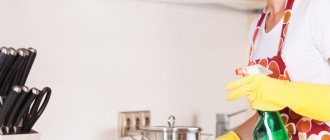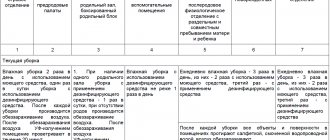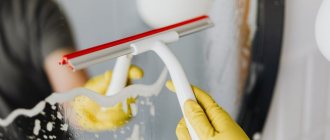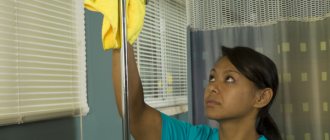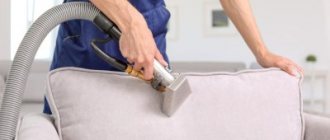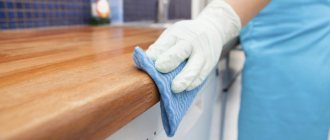Cleaning in a hospital is a constant process, since we are talking about a medical institution where the requirements for disinfection, asepsis and antiseptics are very high. According to sanitary and epidemiological standards, each hospital room should be cleaned using a certain technology using disinfectant solutions and cleaning equipment allocated individually for each room.
- Types of hospital cleaning
- Cleaning rooms in a hospital
- Cleaning corridors in a hospital
- Hospital cleaning solutions
Routine and general cleaning in a medical facility can only be carried out by specially trained and qualified personnel.
Types of hospital cleaning
There are several methods that are regularly used in medical institutions:
- physical (ultraviolet irradiation, steam, boiling method);
- mechanical (wet types of cleaning, regular washing of staff’s hands, repair work);
- chemical (soaking in disinfectant solutions with complete immersion of objects, use of bulk and spraying agents);
- combined (two or more methods are alternated by a medical professional).
Conditions for the procedure
The cleaning of cleaning equipment is carried out in the same way as the disinfection of washcloths and scissors in health care facilities. Personnel at least eighteen years of age and persons for whom the relevant types of work are not contraindicated for medical reasons are allowed to work. You cannot trust those who suffer from chronic allergies, bronchial asthma, or any other systemic disease to carry out the described set of measures. Workers authorized to carry out disinfection of cleaning equipment must regularly attend classes that provide training in labor protection and compliance with safety measures when working with disinfectant compounds.
The administration of the institution is obliged to provide employees with personal protective equipment: gowns, rubber gloves, respirators, goggles. In order to carry out high-quality disinfection of bathtubs, washcloths, scissors in surgery, rags and cleaning equipment in catering establishments, organizations must have a room not only for storing the tools used, but also for washing and disinfecting basins, mops and brooms, rags, rags and brushes . It is mandatory to have lockers for storing staff uniforms.
A first aid kit should be collected to provide first aid in case of signs of poisoning with disinfectant solutions. Each member of the staff must know the telephone number and address of the nearest medical center where they can seek primary medical care in an emergency if an emergency occurs due to a violation of safety rules.
For failure to comply with the conditions of the procedure and mandatory requirements, or for improper disinfection of cleaning equipment, persons who committed violations bear civil and administrative liability. If it is proven that neglect of one's duties caused harm to the health of an individual or group of persons, the responsible person will bear criminal liability. It is regulated by Article 236 of the Criminal Code of the Russian Federation.
Compliance with the rules of disinfection of cleaning equipment is of great importance: it helps to prevent the spread of dangerous infections and maintain a favorable sanitary and biological background.
Cleaning rooms in a hospital
There are the following types of cleaning of hospital wards:
- current - 2 times a day;
- general - once a month.
Equipment used for cleaning must be marked: they write on it what rooms and types of cleaning it is intended for or are marked with the appropriate color. It must be used in accordance with its intended purpose and stored in a specially designated unit. In the same block there is usually a “decoding” of inventory color tags, if any.
Cleaning personnel are regularly trained to always be aware of the rules for carrying out sanitary measures and not to forget about the intricacies of their implementation. Rooms are cleaned wearing a robe, hat and gloves.
The algorithm for staff actions during routine daily cleaning of wards should look like this:
- a health worker warns patients about the upcoming cleaning;
- puts on a special gown and other protective equipment;
- examines the ward;
- prepares disinfectant solutions;
- wipes all horizontal surfaces in the room, as well as doors, furniture and appliances;
- cleans the sink;
- takes out the trash;
- mop the floor;
- ventilates the room for 15 minutes;
- carries out quartz treatment;
- disinfects, cleans and dries equipment.
It is customary to carry out general cleaning of the wards at least once a month. Unscheduled general cleaning is carried out in the event of an unfavorable epidemiological situation or in the event of positive tests from the laboratory for one or another pathogenic microflora.
They carry out general cleaning in the wards with the doors and windows open, without the presence of patients. They should be warned in advance that they need to make the beds and help those who cannot do this themselves. They begin the cleaning process by completely moving all the furniture away from the walls, gaining free access to areas for processing.
General cleaning includes a complete cleaning of walls, all equipment, furniture, lighting, curtains (blinds), doors, baseboards and floors. Window cleaning should also be carried out regularly, 2 times a year, if possible combining it with general cleaning.
General definition
Routine cleaning of wards, routine cleaning of the office and other premises is one of the items on the list of measures and sanitary measures carried out for anti-epidemic purposes. First of all, routine cleaning of the ward and routine cleaning of other areas is aimed at preventing infection that may spread within the hospital.
The schedule and frequency with which routine cleaning of offices is done may vary - in addition to the two mandatory ones, additional cleaning and disinfection must be done between operations. In all cases when scheduled routine cleaning of premises is carried out, the following types of work must be completed:
- Cleaning from various passive contaminants. Dirt, dust, and other surface contaminants.
- Disposal of biological waste, especially carefully if routine cleaning of the operating room is carried out.
- Use of disinfectants. This is done without fail if all premises are being routinely cleaned; for operating rooms and wards, additional disinfection can be carried out in several stages.
Routine cleaning of hospital wards has the main goal of destroying microorganisms that can multiply on various surfaces and be the causative agents of various diseases, including serious ones.
Regulatory documents and requirements
The basic regulatory document, the regulations for the sanitation, procedural quartz - SanPiN 2.1.3.2630-10. In addition to the rules for performing sanitary processing, it includes requirements for the equipment and medical equipment of the office, and interior decoration.
In addition, requirements for medical personnel cannot be excluded. For example, to their compliance with the rules of personal hygiene and hand washing.
A treatment room is an office whose operating mode corresponds to cleanliness classes A and B. The current treatment is carried out unscheduled if the office becomes dirty during operation. When there are no such signs, usually 2 current washes are enough - they are included in the work schedule of the treatment room. The process is controlled by a senior nurse. The main requirement when cleaning is not to violate the standards and established recommendations of SanPiN.
By following the algorithm for general cleaning of the treatment room and routine sanitation, you can eliminate the risk of spreading infection. The premises of the medical facility must be sterile. This is the key to health.
Disinfection of cleaning equipment
Cleaning equipment must be disinfected after use. So, to disinfect rags, you need a separate container (for example, a bucket) and a disinfectant solution. The algorithm for disinfecting rags looks like this:
- The rags are completely immersed in a container with a disinfectant solution and left for the disinfection period;
- At the end of the exposure, the rags are removed from the disinfectant solution and washed under running water;
- The washed rags are dried;
- After complete drying, the rags are stored in a labeled container (for example, boxes).
Removable mops are also processed using the same principle.
Mops are disinfected by wiping with a rag soaked generously in a disinfectant. Then rinse them with running water and dry.
Carts for cleaning equipment are disinfected by wiping with a rag soaked in disinfectant. means. After that, the remaining disinfectant is removed with a clean rag soaked in water.
Buckets and other containers used for cleaning should be stored separately. Buckets cannot be inserted into one another.
Wet cleaning of the office
An algorithm for wet cleaning of the treatment room has been developed. It is preferable to perform it using the so-called mop technique, which cannot cause harm. A mop is a tool prepared in advance, with which wet sanitation is carried out. The mop method has the following features:
- For each individual office in which tidying will take place, it is necessary to prepare the required number of napkins, mops and other equipment.
- The equipment cannot contradict the sanitation requirements of a particular medical office.
- Inventory must be marked with stickers of different colors according to the type of work or room. This helps make the tool selection process much easier.
- All prepared mops and napkins must be treated in advance with a disinfectant solution (0.05 ml of the drug for each napkin, 0.25 ml for each mop).
- The equipment that has been prepared is placed on a special cart for sanitation.
The algorithm for routine cleaning of the treatment room involves washing using equipment and supplies that are specially designed for use in medical institutions. To create it, materials are used that ensure the comfort of the procedure and a long period of operation even with active daily use.
Napkins and mops are also allowed to be used repeatedly, but only if they are systematically washed and disinfected. The final cleaning algorithm for the treatment room is also based on this method. The Mop method is a selection technique. But it makes it possible not only to guarantee compliance with sanitary epidemiological requirements in medical institutions, but also leads to a reduction in the burden on medical personnel. It reduces the risk of developing musculoskeletal diseases and other occupational pathologies.
In addition, the “non-bucket” method of wet cleaning of the treatment room allows a medical institution to significantly reduce costs associated with the purchase of new equipment and the purchase of consumables. By following the rules for cleaning the treatment room, you can achieve ideal sterility of the room, equipment, and instruments.
The main algorithm for carrying out routine cleaning in health care facilities
What stages are the current cleaning that is carried out in a medical facility divided into? There is a special algorithm that is approved by SanPin.
The sequence will be like this:
- The cleaner, strictly in overalls, must move away all objects that are movable. This applies primarily to furniture. After it has been moved away from the walls, you need to thoroughly wash all surfaces using detergents.
- Wash off chemical residues with clean water.
- Using disinfectant solutions ( buy these! ), surfaces are thoroughly treated. At this stage, you cannot rush, since the composition used requires a certain time for the high-quality and complete destruction of pathogenic microorganisms.
- The next step is to change aprons and gloves. Next, the cleaner must thoroughly rinse off all residual disinfectants from the surfaces being treated with clean water. After this they are wiped dry.
- Now the floor is being washed.
- All premises must be disinfected. Ultraviolet light is used for this.
The current cleaning of the health care facility is completed in accordance with the standards by cleaning all equipment. The devices will need to be washed and dried, after which they are sent to specially designated rooms for storage. All work clothes go to the laundry.
